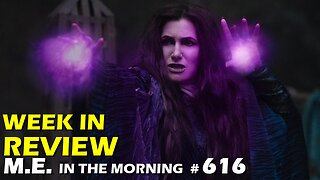"The Horror From the Hills" by Frank Belknap Long
0:00:00 Chapter 1 - The Coming of the Stone Beast
0:50:13 Chapter 2 - The Atrocity at the Museum
1:26:06 Chapter 3 - An Archaeological Digression
1:35:55 Chapter 4 - The Horror on the Hills
1:37:56 Chapter 5 - Little's Dream
2:20:58 Chapter 6 - The Time-Space Machine
2:38:40 Chapter 7 - A Cure for Scepticism
2:42:48 Chapter 8 - What Happened in the Laboratory
2:51:33 Chapter 9 - The Horror Moves
3:05:22 Chapter 10 - Little's Explanation
----
This story was published in 1931. It is considered part of the Cthulhu mythos, so if it feels Lovecraftian, there's a reason for it.
The whole aspect of Chaugnar Faugn is Lovecraftian, but there are other little details that are extremely Lovecraftian but super subtle to those not well versed in the lore. Like the statue being made of a black stone with a greenish sheen. Things like that show just how much Long was into the lore himself.
Speaking of Chaugnar Faugn, it is worth bearing in mind that according to Lovecraft himself, the pronunciation of these names by humans can never be correct as we lack the biological physiognomy to make the necessary sounds. Which is to say, if you don't like my pronunciation, it doesn't matter, yours would also necessarily be wrong regardless :-P
Chapter 5 was told in its own entirely separate story by H.P. Lovecraft entitled "The Very Old Folk"
The pictures used are:
Chapter 1: "Chaugnar Faugn" by jsantiagogutierrez, used here under the Creative Commons Attribution-NonCommercial-NoDerivs 3.0 Unported license (https://creativecommons.org/licenses/by-nc-nd/3.0/)
Chapter 2: postcard of the Museum of Natural History, circa 1930
Chapter 3: Nkisi Nkondi, Kongo people, Democratic Republic of the Congo, 19th century. Room 25, British Museum. Ethno 1905.5-25.3
Chapter 4: "The Pyrenees mountains in December" by Mike McBey, used here under the Creative Commons Attribution 2.0 Generic license (https://creativecommons.org/licenses/by/2.0/)
Chapter 5: a re-enactor depicting a Roman Centurio 70 a.C. during a show of Legio XV from Pram, Austria Weinstock als Rangabzeichen Beinschienen, by Medium69, used here under the Creative Commons ttribution-ShareAlike 3.0 Unported license (https://creativecommons.org/licenses/by-sa/3.0/deed.en)
Chapter 6: "The time travel cabin" by AI-Postcards, used here under the Creative Commons Attribution-NonCommercial 3.0 Unported license (https://creativecommons.org/licenses/by-nc/3.0/)
Chapter 7: Byrant Park some time in the 1920s or very early 30s. That's the rear of the New York Public Library at the east end of the park
Chapter 8: the boardwalk and band pavilion in Asbury Park, circa 1930
Chapter 9: "View south across Sand Marsh from Cape May County 619 (Ocean Drive) in Stone Harbor, Cape May County, New Jersey" by Famartin, used here under the Creative Commons Attribution-ShareAlike 4.0 International license (https://creativecommons.org/licenses/by-sa/4.0/deed.en)
Chapter 10: Thomas Edison's assistants—(left to right) George Hill, Charles T. Hughes, Samuel D. Mott, and Francis Jehl—photographed at the Menlo Park laboratory in New Jersey around 1880. Courtesy of The Henry Ford
Despite the story having been published in the 1930s in Weird Tales, I can't seem to find an online version of it anywhere. The book I'm reading from does have some obvious editing errors (e.g. "...it looked, in spots, as thought it had been..." should be "as though it had") which I've taken the liberty of cleaning up when they are so glaringly obvious. There are a few instances though where it's not obvious if there's an error, and with no other source to compare against, I generally leave those as they appear in the book.
I am reminded of the old 1980s Dungeons and Dragons cartoon, and how every time the kids defeated Venger, Venger would loom large above them in smoke form before dissipating away, exactly like Chaugnar is described as doing. I wonder if the script writer there had read this story?
-
 1:02:08
1:02:08
Dr. Eric Berg
3 days agoThe Dr. Berg Show LIVE September 20, 2024
22K8 -
 39:43
39:43
The Rubin Report
2 hours agoIs This the Issue That Finally Causes Dave Portnoy to Break with Democrats?
26.5K13 -
 LIVE
LIVE
Film Threat
16 hours agoTHE SUBSTANCE + TRANSFORMERS ONE + TONS OF REVIEWS | Film Threat Livecast
689 watching -
 39:26
39:26
Tudor Dixon
3 hours agoSean "Diddy" Combs Sex Trafficking Exposed | The Tudor Dixon Podcast
8.99K3 -
 LIVE
LIVE
Midnight's Edge
2 hours agoAgatha and The Penguin are here, Female Zorro and more Terminator movies coming! | MEiTM #616
259 watching -
 LIVE
LIVE
The Shannon Joy Show
5 hours ago🔥🔥Health ELITES Exposed! The Dirtbag JAY VARMA And The Monsters & Morons Among Us! STUNNING Revelations About The Incompetence & Depravity Of The People In Charge Of Your Health🔥🔥
371 watching -
 18:21
18:21
Dr David Jockers
1 hour agoHow to do a Liver Cleanse the Right Way!
4.22K -
 1:38:13
1:38:13
Benny Johnson
2 hours agoBOMBSHELL: Multiple 'Assassination Teams' Are HUNTING Trump Across US | DeSantis FIGHTING With FBI
42.4K51 -
 2:57:00
2:57:00
Pardon My Take
6 hours agoAARON RODGERS IS BACK, WOJ RETIRES + SPICE ADAMS ON BECOMING A MEME
22.4K1 -
 LIVE
LIVE
Major League Fishing
7 days agoLIVE! - General Tire Team Series: Heritage Cup - Day 6
322 watching